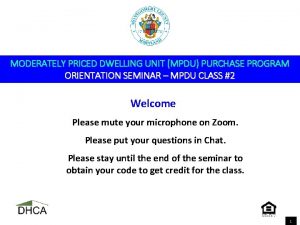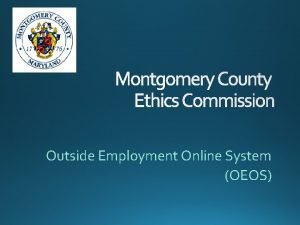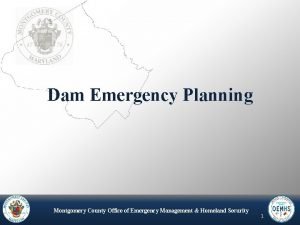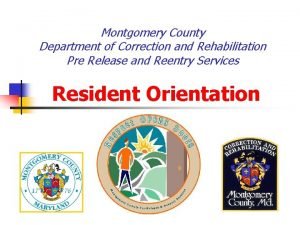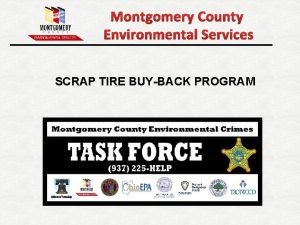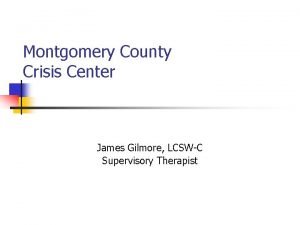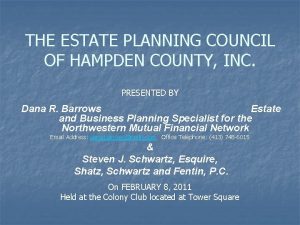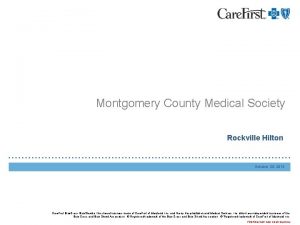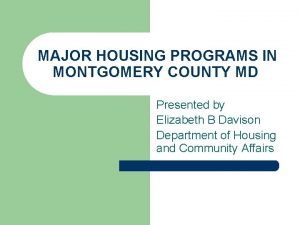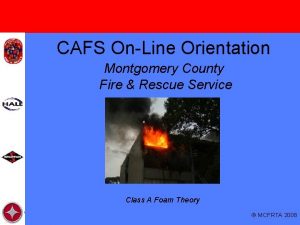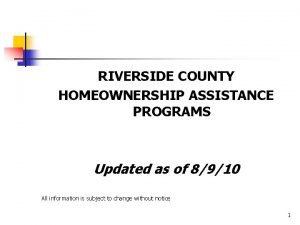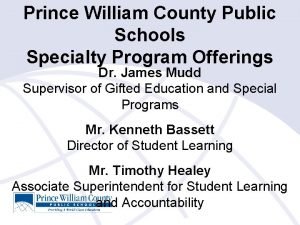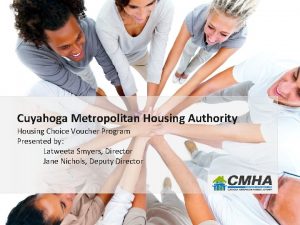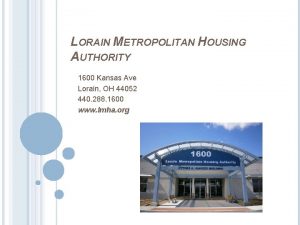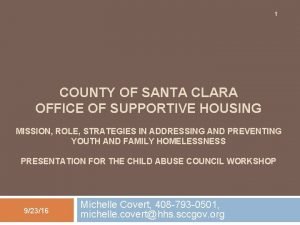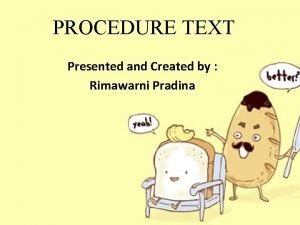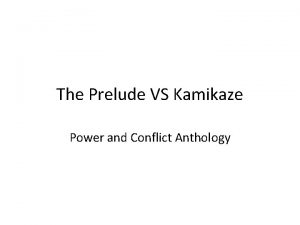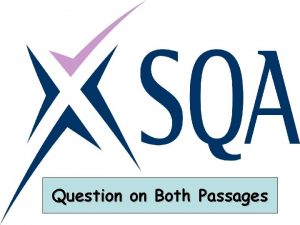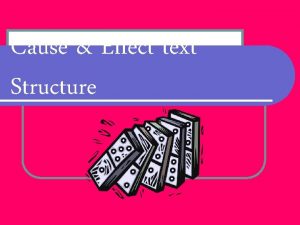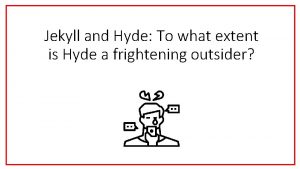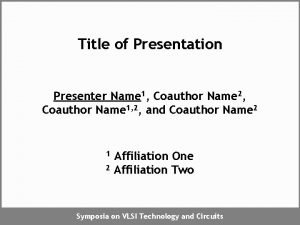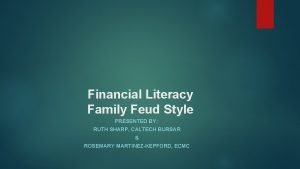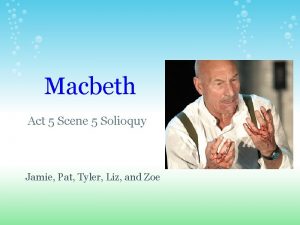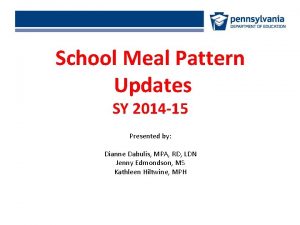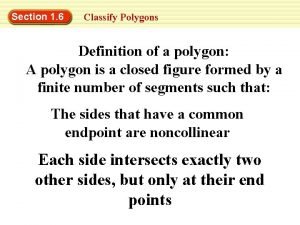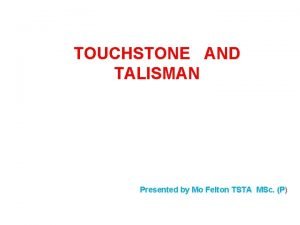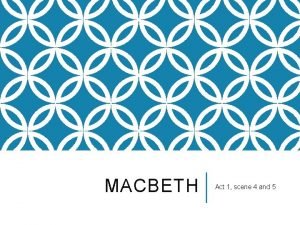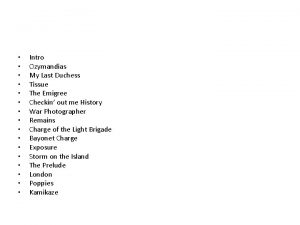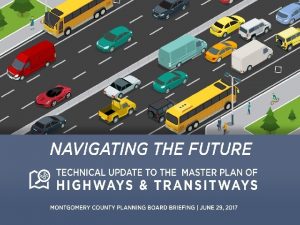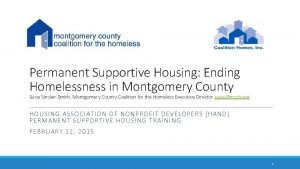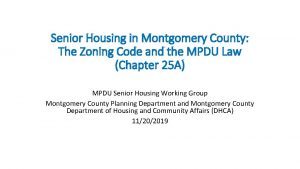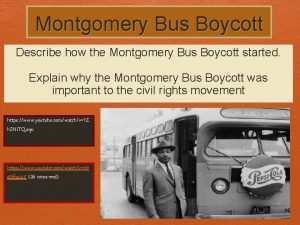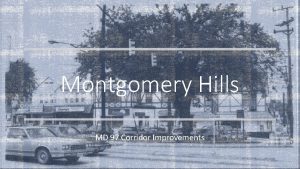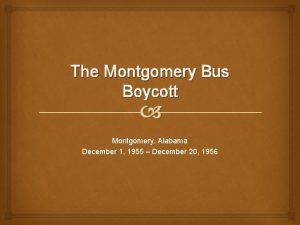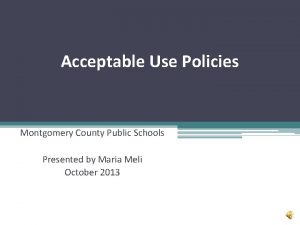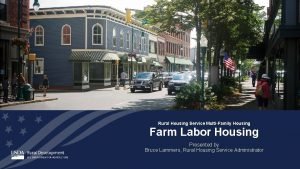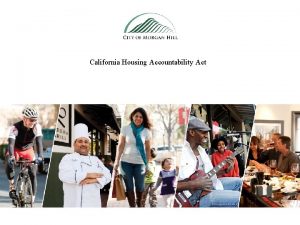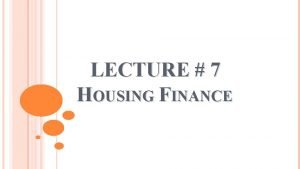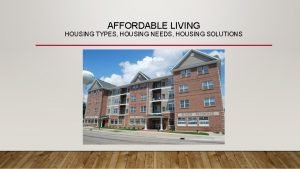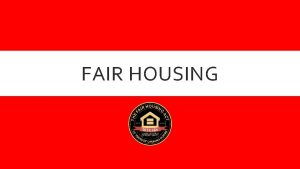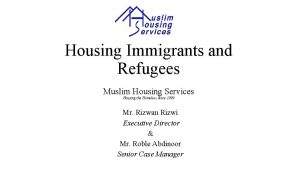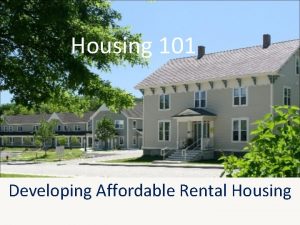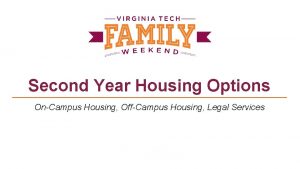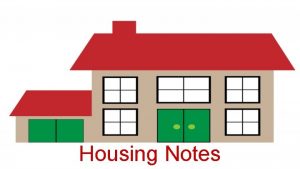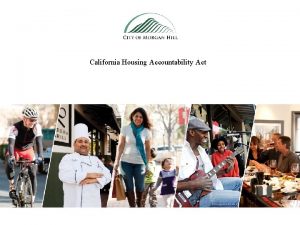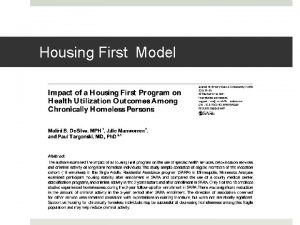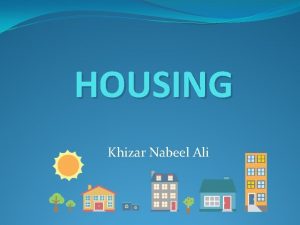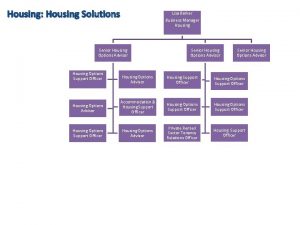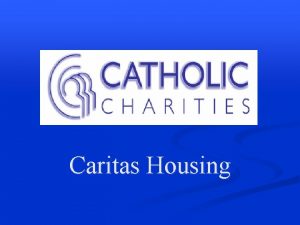MAJOR HOUSING PROGRAMS IN MONTGOMERY COUNTY MD Presented











































- Slides: 43

MAJOR HOUSING PROGRAMS IN MONTGOMERY COUNTY MD Presented by Elizabeth B Davison Department of Housing and Community Affairs

Montgomery County Known for Innovative Housing Programs l l Moderately Priced Dwelling Unit Ordinance Condominium Conversion laws Right of First Refusal on Sale of Multifamily Housing Initiative Fund

Moderate Priced Dwelling Unit Program

The Moderate Priced Dwelling Unit Program In Brief è è è Priced to be affordable to moderate income households Required in subdivisions of 20 units or more Enacted in 1974, produced 11, 700 housing units An “inclusionary zoning” technique – Allow density bonuses above the base zone è MPDU sales prices controlled for 30 years; MPDU rents controlled for 99 years è County and the owner split the “windfall” profit after control period è The first inclusionary zoning program in the country è Montgomery County, Maryland

Montgomery County, Maryland Moderately Priced Dwelling Unit (MPDU) Program Background – Demographics (2000 Census): A relatively diverse, higher income population with children People Total Population Estimate (7/1/2004) 873, 341 921, 690 Under age 18 25. 4 % Over age 65 11. 2 % White 73. 6 % Black 15. 1 % Asian 11. 3 % Hispanic (all races) 11. 5 % Median Income (2005) $89, 300 Housing Total households 324, 565 Single-family detached 51. 2 % Single-family attached 17. 9 % Multi-family 30. 7 % Owner Occupied 68. 7 % Renter Occupied 31. 3 % Montgomery County, Maryland

Montgomery County, Maryland Background - Current housing situation: 2004 Median Housing Sales Price New Resale SF Detached $666, 540 $450, 000 SF Attached $427, 501 $283, 500 All Single Family $395, 000 Average Rent (2004) Efficiency $ 887 1 -BR $1, 027 2 -BR $1, 211 3 -BR $1, 526 HUD/FMR (2004) $ 913 $1, 039 $1, 218 $1, 660 HUD limit for family of four (2005) @ 50% of median…………$44, 650 Montgomery County, Maryland

Legislative History of MPDU Program in Early 1970’s l l l Civic pressure from Fair Housing advocates and the League of Women Voters A concept to have builders supply a percentage of houses in each development that would be “affordable” Issues: l l l “Taking” of property Successful economic integration of neighborhoods “Marketing” developments with mixed incomes The economic impact of affordable units on housing values Density bonuses undermining “pristine” zoning practices Montgomery County, Maryland

The Moderately Priced Dwelling Unit Ordinance : Goals and Implementation Goals of the MPDU Program: è è Distribute low and moderate income households throughout the County Expand inventory of low and moderate -income housing for the County Housing authority and nonprofits to retain long term ownership of affordable units Funds future affordable housing by sharing windfall appreciation. Implementing the MPDU Goals: è è Partnership with developers: Density bonus (22%) to off-set land other costs. Apply MPDU requirement county-wide to achieve distribution of MPDUs in every community. Off-set expiration of MPDU inventory by purchase of portion of units by Housing Authority or non profits. Dedicating shared profits from sales after price controls to the County’s housing trust fund. Montgomery County, Maryland

Montgomery County, Maryland Moderately Priced Dwelling Unit (MPDU) Program The public policies underpinning the law include: è è è Providing a full range of housing choices Provide affordable housing to meet employment needs Disperse affordable housing throughout the county Allow increased densities to off-set the additional costs to developers provide flexibility for developers to meet the MPDU requirement Montgomery County, Maryland

Montgomery County, Maryland Moderately Priced Dwelling Unit (MPDU) Three County Agencies with Responsibility: è è è The Planning Board The Department of Housing and Community Affairs (DHCA) The Department of Permitting Services (DPS) Montgomery County Government must: è è è è administer the zoning and plan approval assure that the project’s MPDU requirements are documented certify consumer eligibility establish agreements with developers on staging establish MPDU pricing oversee the selection of potential buyers through the lottery enforce resale and shared profit restrictions

Profile of Consumers Moderately Priced Dwelling Unit (MPDU) Program è Maximum Income Range: For Sale $44, 000 (individual) to $68, 000 (family of 5) Rental è è $40, 000 (individual) to $62, 000 (family of 5) Maximum income limits are set at about 65% to 70% of median Average income of purchasers - $32, 000 Number of certificate holders - 1, 300 MPDU purchasers are: è Employed è Hold jobs in the retail and service sectors, often multiple jobs at one time è Entry level teachers, firemen and police officers Montgomery County, Maryland

The Moderately Priced Dwelling Unit Ordinance: l Achieving Compatibility: judge the results by identifying the MPDUs Montgomery County, Maryland What do they look like?

The Moderately Priced Dwelling Unit Ordinance: Design Compatibility is a Must. MPDUs l Achieving Compatibility: judge the Rate the MPDUs results by. Market identifying MPDUs Market Rate MPDU duplexes in a single family detached community. Montgomery County, Maryland

The Moderately Priced Dwelling Unit Ordinance: Dispersal Throughout the Community Montgomery County, Maryland

The Moderately Priced Dwelling Unit Ordinance Does it Work? Yes. Is it Perfect? No. l l l Benefits Housing for needed workers. Homeownership opportunities Access to schools and services Prevents ghettos and mainstreams low income l l l Issues Dependent on market rate new construction Cost in High Rise Large Waiting list Credit issues for applicants Enforcement of Covenants Montgomery County, Maryland

Questions and More Info l Christopher. anderson@ montgomerycountymd. gov More Background informatination, forms and regulations: www. montgomerycountymd. gov/mpdu

Condominium Conversions and Right of First Refusal

Condominium Conversions: Back to the Future l l Similar to condo craze of late ’ 70’s early 1980’s New construction of condominiums began a few years ago as high end rentals became saturated Conversion of high end properties well underway Laws from 1980’s apply but need update Page 2

Status of Conversions In Montgomery County l l l 19 complexes are in early stages of conversion Represents 3, 850 Units Only 3 buildings has gone through conversion process Half the buildings converting by owner 1 building a tenant sponsored conversion 5 properties created as condominium, but initially rented, now being sold Page 3

Several Laws Regulate Conversions l l Ch 53 A: Montgomery County Right of First Refusal Title 11: State of Maryland Condominium Conversion Ch 11 A: Montgomery County Condominium Conversion Ch 29: Montgomery County Landlord Tenant Law Page 5

Right Of First Refusal: 53 A l Gives Right to Certified tenant organization, County, Housing Authority l Must match price and terms Page 6

Title 11 State of Maryland Condominium Conversion Law l l l Requires extended tenancies for protected classes up to 20% of units Allows Local government to extend protections Defines protected classes as those: - over 62 years of age, – – “Handicapped”/ mobility impaired, Under 80% of median income Page 7

Ch 11 A Montgomery County Condominium Conversion l Extends protections in state law to Lifetime Tenancies: Over 62 or “handicapped” and – under 80% of median income, and – Tenant for at least 12 months q Includes 3 year tenancies for persons with disabilities, seniors, or any person under 80% median income – Page 8

Other Provisions l l Tenants have right of first refusal on their unit HOC and County have Right of first refusal on entire building, also of up to 20% of the individual units Relocation payments to tenants on a reimbursement basis up to $750 Priority for extended tenancies by length of residence in property Page 9

The Housing Initiative Fund l A Housing Trust Fund of Local Money Dedicated to Promote Affordable Housing

The Housing Initiative Fund Adopted As part of the County Code in 1988. Purpose Establishes a trust fund to promote a broad range of housing opportunities in Montgomery County.

Goals of the Housing Initiative Fund 1. Renovating distressed properties. 2. Preserving housing that could be lost from the affordable housing stock. 3. Special needs housing. 4. Helping create mixed-income communities. 5. Making sure that housing programs build neighborhood and not just housing units. 6. Working toward an equitable distribution of affordable housing units.

Sources of Revenue for the Fund Current sources: General fund: 2. 5% of property Tax • Sale of moderate priced housing • Sale of publicly owned land • Investment income • Loan repayments • Developer payments Past sources: • Condominium conversion tax • Impact tax • Property rental • State contributions

The Problem of Uneven Funding: Solved by 2. 5% of Property Tax

Administration of the Fund

Process for Approval 1. Developer submits application to the Department of Housing and Community Affairs. 2. Housing Loan Committee reviews proposal in monthly meeting 3. Presentation to Director final decision 4. Dispersal of funds to developer if approved

Factors Considered During the Review Process Purpose: ü Complies with HIF mission ü Public purpose ü Neighborhood need üNeed for physical improvement Compatibility: ü Project design ü Land use and zoning ü Community support Feasibility/cost: ü Financial feasibility and need ü Leveraging ü Cost reasonableness ü Market feasibility ü Readiness to go forward ü Availability of support services ü Development team capacity

Important Note: For every dollar of local funding spent, the Housing Initiative Fund was able to leverage seven dollars in resources from private, federal, and state sources.

Case Studies

Preservation: Stewartown Homes Apartments Property: 94 unit complex, one third uninhabitable when acquired by the housing authority. Expiring “ 236” property. HIF role: 30 year loan at 1%, with no payments for 17 years and no interest accruing. Rehab costs of $120 K/unit. Leverage ratio of County funds: 5. 24 to 1.

Community Preservation and Development Corp. runs a computer learning center and after school job training at Stewartown Homes Apartments. Goals met by this project: 1. Renovating distressed properties. 2. Preserving housing that could be lost from the affordable housing stock. 3. Making sure that housing programs build neighborhood and not just housing units.

Rehabilitation: Montgomery Arms Apartments Property: Historic 130 unit complex located in downtown Silver Spring built in the 1940 s. Owned by the housing authority. HIF role: $2 million, 30 year loan at 3%, no payments for 6 years, no interest accruing. In 7 th year, payment to be based on available cash flow.

Conditions: 84 units reserved for families and individuals in affordable housing programs. Of these, 10 are “Mc. Kinney Act” units for chronically mental ill persons. 46 units leased at market rate. Goals met by the project: Rehabilitation and upgrading underway at Montgomery Arms. 1. Renovating distressed properties. 2. Special needs housing. 3. Helping create mixed-income communities. 4. Working toward an equitable distribution of affordable housing units.

New Construction: Victory Terrace Property: Former 16 -acre school site (surplus), purchased by nonprofit housing developer Victory Housing. Located in Wealthy Potomac HIF role: Two loans: a land purchase loan to defer payments, with no interest accrual, for 20 years. Predevelopment and development loan will have 1% interest only payments for 5 years, then fully amortized for remaining 35 years. Both loans to be cash flow loans. Conditions: 72 units with 14 affordable to persons at or below 40% of the area median income, 44 units to persons at or below 60%. Remaining 14 units unrestricted.

Goals met by the project: 1. Special needs housing. 2. Helping create mixed-income communities. 3. Working toward an equitable distribution of affordable housing units.

Transitional Family Housing and Single Room Occupancy: Econolodge makeover Property: 99 room motel in two buildings. HIF role: $287, 246 towards purchase of the motel by the County. Housing authority to serve as development manager during construction.

Econolodge makeover: Conditions: 40 living units will be created for single adults needing permanent supportive housing and 17 2 -bedroom apartments will be created for families needing 3 -6 month transitional housing, operated by the Montgomery County Coalition for the Homeless, Inc. under partnership with DHCA and HHS. Goals Met by the project • Renovating distressed properties. • Special needs housing. • Making sure that housing programs build neighborhood and not just housing units.

For more information, please contact Stephanie Killian, Multifamily Housing Manager http: //www. montgomerycountymd. gov/content/hca/Housing/mutifamily-intro. htm
 Mpdu class registration
Mpdu class registration Montgomery county ethics commission
Montgomery county ethics commission Montgomery county md
Montgomery county md Montgomery county pre release center
Montgomery county pre release center Montgomery county environmental services
Montgomery county environmental services Montgomery county crisis center
Montgomery county crisis center Montgomery county estate planning council
Montgomery county estate planning council Montgomery county medical society
Montgomery county medical society Mpdu montgomery county md
Mpdu montgomery county md Smoke detector repair montgomery county
Smoke detector repair montgomery county Disadvantages of waterfall model in software engineering
Disadvantages of waterfall model in software engineering 2 categories of software
2 categories of software Riverside county first time homebuyer program
Riverside county first time homebuyer program Speciality program pwcs
Speciality program pwcs Cuyahoga county section 8 application
Cuyahoga county section 8 application Pd&r
Pd&r Lmha oberlin homes
Lmha oberlin homes Santa clara county office of supportive housing
Santa clara county office of supportive housing Cognitive learning theory was presented by
Cognitive learning theory was presented by Kinds of headlines in journalism
Kinds of headlines in journalism Professionally presented
Professionally presented Proudly presented by
Proudly presented by Text
Text Kamikaze power of nature
Kamikaze power of nature Which idea is presented in both passages
Which idea is presented in both passages Plant assets natural resources and intangible assets中文
Plant assets natural resources and intangible assets中文 As presented below
As presented below Young and dyslexic igcse analysis
Young and dyslexic igcse analysis Example of cause and effect text type
Example of cause and effect text type Hyde as a frightening outsider
Hyde as a frightening outsider Slide todoc.com
Slide todoc.com Caltech bursar
Caltech bursar Macbeth act 5 scene summaries
Macbeth act 5 scene summaries What type of conics is presented in a tilted glass of water
What type of conics is presented in a tilted glass of water Presenters name
Presenters name Presented sy
Presented sy Identify the type of polygon
Identify the type of polygon Introduction to technical drafting
Introduction to technical drafting Talisman presented
Talisman presented Technological design definition
Technological design definition Jekyll and hyde quotes
Jekyll and hyde quotes Madtshirt
Madtshirt Macbeth act 1 scene 3 translation
Macbeth act 1 scene 3 translation Ozymandias and london venn diagram
Ozymandias and london venn diagram
